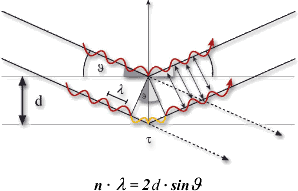
Using x-ray diffraction analysis it is possible to determine the chemical bindings of crystalline substances. This makes it possible to identify substances contained in the sample. The results correlate with an international database consisting of several thousands of substances.
The principle of X-ray Diffraction Analysis
The principle of X-ray diffraction is characterised by Bragg’s law of reflection:

A parallel incoming beam (red) is reflected on the so-called network-level of an atomic structure. Thereby, the lower X-ray covers a longer distance. This phase difference (yellow) is called path difference (t).
If the path difference corresponds to a multiple of an X-ray’s wavelength (l), X-ray reflections emerges through constructive interference.
Due to the atomic structure of every compound, an individual and typical series of X-ray reflections emerges which can then be classified to a specific substance.
In the field of X-ray diffraction, we are specialised on inorganic solids. Our customers value our know-how in the following fields:
- Techno-medical products (e.g. ceramic teeth, dental implants)
- Refractories (metallic silicon, silicon carbide, corundum, zircon, etc.)
- Clay and glass-ceramic manufactures (kaolin and silicate glass raw material)
- Electrochemical sensors
- Inorganic filter and pigment substances
- Cement raw materials (carbonate, sulphate, etc.)
- Construction, insulating and absorbing-sound materials
- Natural rock and stones (granite, marble, sand stone, slate)
- Industrial minerals (salts, ores, zeolites, quartz, diamond, etc.)
